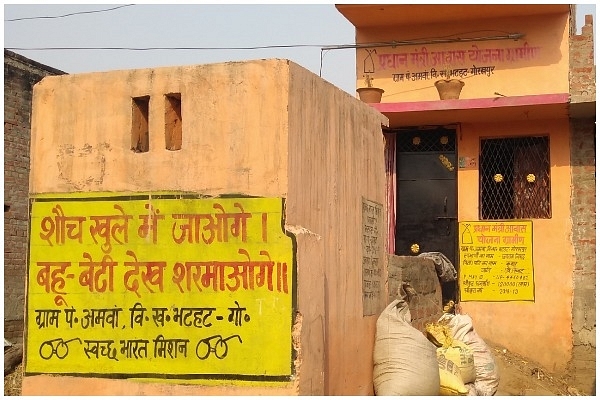Health
Economic Survey In Graphs: The Impact Of Swachh Bharat Mission On Health, Explained
- What the Economic Survey says about the impact of the Swachh Bharat Mission on the health of children below five years of age.

A home and a toilet built under government schemes. (Prakhar Gupta/Swarajya)
Sanitation and health are closely linked — without improving the former, it is difficult to better the latter. With the implementation of the Swachh Bharat Mission (SBM) — world's largest behavioural change programme — in 2015, India attempted to exploit this linkage. Five years later, the Economic Survey for 2018-19, tabled by Finance Minister Nirmala Sitharaman in the Rajya Sabha today, supplies data to suggest that the SBM has succeeded on this front.
Data On Sanitation Coverage
According to the survey, over 9.5 crore toilets have been built all over the country under SBM till June of this year. As a result, 98.9 per cent of India has been covered under SBM. The rate of construction of household toilets has improved from less than 50 lakh per year and to over 3 crore per year.
The report says that around 93.4 per cent of the villages in the country, 96.20 per cent gram panchayats, 88.6 per cent of blocks and 618 districts are now Open Defecation Free (ODF), which means that a) no visible human faeces are found in the environment and b) every household has a safe option for disposal of human faeces.
However, some states continue to lag behind. Goa has the lowest Individual Household Latrine (IHHL) coverage, followed by Odisha and Telangana. Under SBM, an incentive of Rs 12,000 is provided by the centre and the state (in a 60:40 ratio in most states) for the construction of an IHHL.
Impact Of Improving Sanitation Coverage On Health
Diarrhoea, a disease spurred by unsafe sanitation practices, is a major cause of death of children under the age of five in India. At least 11 per cent of deaths of children under the age of five in 2013 was attributed to this disease. But there has been a significant reduction in this number over the last four years. Here’s how the Economic Survey arrives at this conclusion:
Districts in India were divided into two groups — one with low and medium toilet coverage in 2015 and the second with higher coverage. Given that toilet coverage has become almost universal now, one can be sure that more toilets have been built in districts that had low toilet coverage in 2015. Because more households built toilets in such districts, the impact on health should be comparatively greater in those areas.
Between March 2015 — when the implementation of SBM began, and March 2019 — when most districts in the country achieved IHHL coverage of 100 per cent, the government tracked the number of diarrhoea and malaria cases in children below the age of five years, as well as cases of still birth and low birth weight babies.
Their findings are as follows:
One, in line with the theory, it was found that the districts with lower IHHL coverage had more cases of diarrhoea, malaria, still births and low birth weight babies.
Two, after the implementation of the SBM, the number of malaria cases declined from around 761 in 2015 to 113 in 2019 in districts with low toilet coverage and from 222 to 113 in districts with high toilet coverage.
Three, the number of diarrhoea cases declined from 6,968 and 5,262 in the year 2015 to 5,683 and 4,550 in 2019 in the first and second groups, respectively.
Four, in districts with low toilet coverage before the implementation of SBM, the number of still births came down from 540 in 2015 to 456 in 2019. In districts with higher toilet coverage before the implementation of the scheme, the number of still births came down from 403 in 2015 to 368 in 2019.
Five, cases of low birth weight decreased from 3,890 and 3,230 in 2015 to 3,686 and 3,198 in 2019 in the first and second groups, respectively.
Five, it was found that the health indicators of children and mothers from ODF areas were relatively better than those from non-ODF areas.
Have These Results Been Verified By An Independent Agency?
Yes, the Economic Survey cites an independent study conducted by the World Health Organisation (WHO) that shows similar trends.
The study, titled ‘Swachh Bharat — Estimations of potential health impacts from increased sanitation coverage’, states that in 2014, when the SBM was not in existence, about 1,40,000 persons died due to diarrhoea, out of which 39,000 were children below the age of five. After the implementation of SBM across India, the overall mortality from unsafe sanitation declined to about 50,000 deaths in 2017-2018.
Support Swarajya's 50 Ground Reports Project & Sponsor A Story
Every general election Swarajya does a 50 ground reports project.
Aimed only at serious readers and those who appreciate the nuances of political undercurrents, the project provides a sense of India's electoral landscape. As you know, these reports are produced after considerable investment of travel, time and effort on the ground.
This time too we've kicked off the project in style and have covered over 30 constituencies already. If you're someone who appreciates such work and have enjoyed our coverage please consider sponsoring a ground report for just Rs 2999 to Rs 19,999 - it goes a long way in helping us produce more quality reportage.
You can also back this project by becoming a subscriber for as little as Rs 999 - so do click on this links and choose a plan that suits you and back us.
Click below to contribute.
Latest